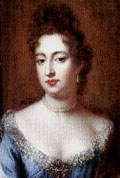 |
Mary II
b. 30 Apr/10 Apr 1662, London
d. 28 Dec 1694/7 Jan 1695, London |
| Title: |
Dei gratia Scotie Anglie Francie et Hibernie Rex et Regina, Fidei Defensores, etc. = By the grace of God, King and Queen of Scotland, England, France and Ireland, Defenders of the Faith, etc. [1] |
| Term: |
11/21 May 1689 - 28 Dec 1694/7 Jan 1695 |
| Chronology: |
11/21 Apr 1689, the crown of Scotland offered to William and Mary as joint sovereigns in "An Instrument of Government, for Settling the Crown and Regal Dignity of the Kingdom of Scotland Upon William III and Mary II, King and Queen of England, &c.", passed by the Convention of the Estates of Scotland, meeting of the Convention, Parliament House, Edinburgh [2] |
|
13/23 Apr 1689, proclaimed by authority of the Convention of the Estates, pending acceptance of the crown, Edinburgh [3] |
|
11/21 May 1689, accepted the crown of Scotland and took the coronation oath, public ceremony, Banqueting Hall, Whitehall, London (regnal years for Scotland counted from 11/21 Apr 1689) [4] |
|
28 Dec 1694/7 Jan 1695, died |
| Names/titles: |
Prinses van Oranje (Princess of Orange) [from 4/14 Nov 1677] |
|
Dei gratia Anglie Francie et Hibernie Rex et Regina, Fidei Defensores, etc. = By the grace of God, King and Queen of England, France and Ireland, Defenders of the Faith, etc. as William III and Mary II [13/23 Feb 1689 - 11/21 May 1689] |
|
Dei gratia Anglie Scotie Francie et Hibernie Rex et Regina, Fidei Defensores, etc. = By the grace of God, King and Queen of England, Scotland, France and Ireland, Defenders of the Faith, etc. as William III and Mary II [11/21 May 1689 - 28 Dec 1694/7 Jan 1695] |
| Biography: |
| Eldest daughter of James Duke of York (afterwards King James II of England or James VII of Scotland) and his first wife, Anne Hyde; remained a Protestant, although his father converted to Roman Catholicism; was married to her cousin Willem Hendrik Prince of Orange (4/14 Nov 1677) and went to live in the Netherlands; supported her husband, who was invited by the Protestant opposition in England to overthrow Mary's father, King James; after the success of the undertaking, arrived to England from the Netherlands and solemnly entered London 12/22 Feb 1689; was offered and accepted the crowns of England (13/23 Feb 1689) and Scotland (11/21 May 1689) together with her husband as joint sovereigns; exercised the royal power in England during William's absences in virtue of "An Act for the Exercise of the Government by her Majesty during his Majesty's Absence" (assented to 20/30 May 1690); was actively concerned with ecclesiastical appointments; died of smallpox at the age of 32. |
| Biographical sources: "The Glorious Revolution of 1688," by Maurice Ashley (Hodder and Stoughton, London, 1966); "The Declaration of Rights," by Lois G. Schwoerer (The Johns Hopkins University Press, Baltimore and London, 1981); "William III, The Stadholder-king: A Political Biography", by Wout Troost (Ashgate, 2005). |
| |
| [1] |
Joint title for William II (III in England) and Mary II, who were offered the crown of Scotland on condition that "... the sole and full exercise of the regal power be only in and exercised by him the said King (i.e. William) in the names of the said King and Queen". |
| [2] |
Proceedings of the Estates in Scotland 1689-1690, 1:35. |
| [3] |
Proceedings of the Estates in Scotland 1689-1690, 1:36. |
| [4] |
Proceedings of the Estates in Scotland 1689-1690, 1:85-89. |
|
Image: portrait of Queen Mary II after William Wissing, c. 1690. |

